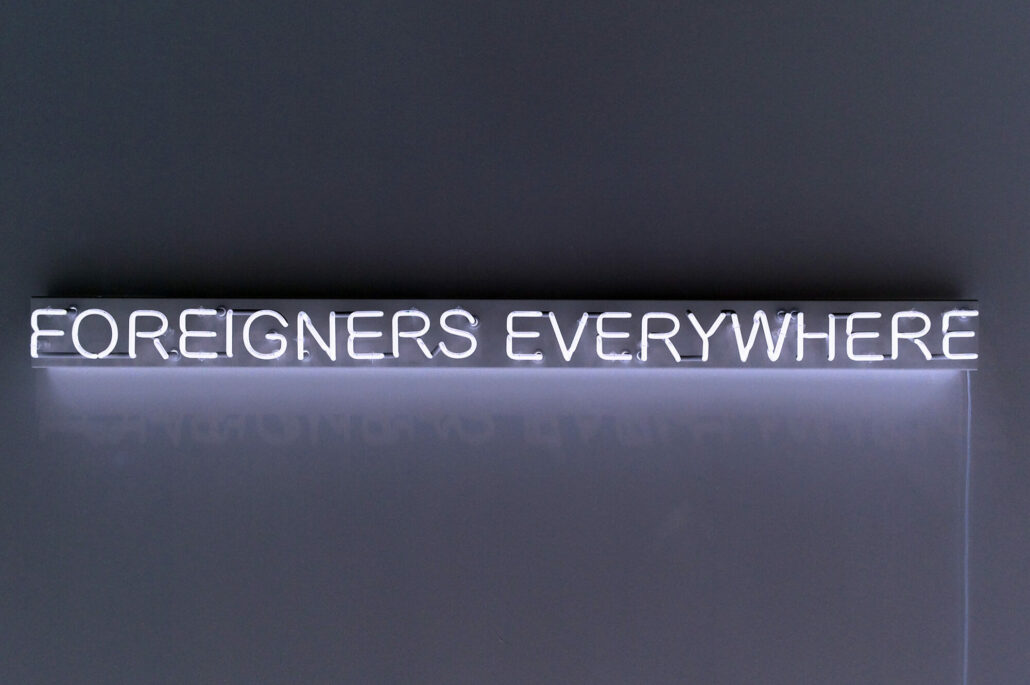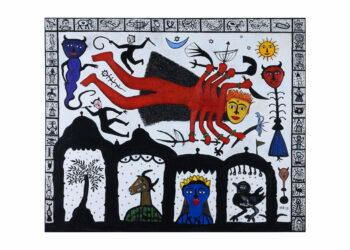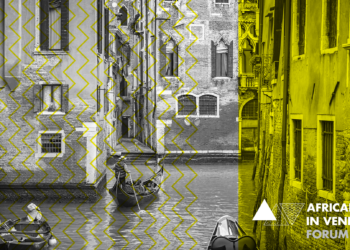The 60th International Art Exhibition, titled ‘Stranieri Ovunque – Foreigners Everywhere’, will open to the public from Saturday April 20 to Sunday November 24, 2024, at the Giardini and the Arsenale; it will be curated by Adriano Pedrosa and organised by La Biennale di Venezia. The pre-opening will take place on April 17, 18 and 19; the awards ceremony and inauguration will be held on 20 April 2024.

Claire Fontaine, Foreigners Everywhere (English), 2005. Tecnolux ultra violet, 10mm glass, back-painted, framework, electronic transformer, cables. Courtesy of Claire Fontaine and Galerie Neu, Berlin.
Since 2021, La Biennale di Venezia launched a plan to reconsider all of its activities in light of recognised and consolidated principles of environmental sustainability. For the year 2024, the goal is to extend the achievement of “carbon neutrality” certification, which was obtained in 2023 for La Biennale’s scheduled activities: the 80th Venice International Film Festival, the Theatre, Music and Dance Festivals and, in particular, the 18th International Architecture Exhibition which was the first major Exhibition in this discipline to test in the field a tangible process for achieving carbon neutrality – while furthermore itself reflecting upon the themes of decolonisation and decarbonisation.
The International Exhibition of the Curator
The Exhibition will take place in the Central Pavilion (Giardini) and in the Arsenale, and it will present two sections: the Nucleo Contemporaneo and the Nucleo Storico.
As a guiding principle, the Biennale Arte 2024 has favored artists who have never participated in the International Exhibition – though a number of them may have been featured in a National Pavilion, a Collateral Event, or in a past edition of the International Exhibition. Special attention is being given to outdoor projects, both in the Arsenale and in the Giardini, where a performance program is being planned with events during the pre-opening and closing weekend of the 60th Exhibition.
‘Stranieri Ovunque – Foreigners Everywhere’, the title of the 60th International Art Exhibition of La Biennale di Venezia, is drawn from a series of works started in 2004 by the Paris-born and Palermo-based collective Claire Fontaine. The works consist of neon sculptures in different colours that render in a growing number of languages the words “Foreigners Everywhere”. The phrase comes, in turn, from the name of a Turin collective who fought racism and xenophobia in Italy in the early 2000s.
“The expression Stranieri Ovunque”, explains Adriano Pedrosa, “has several meanings. First of all, that wherever you go and wherever you are you will always encounter foreigners – they/we are everywhere. Secondly, that no matter where you find yourself, you are always truly, and deep down inside, a foreigner.”
Nucleo Contemporaneo
“The Italian straniero, the Portuguese estrangeiro, the French étranger, and the Spanish extranjero, are all etymologically connected to the strano, the estranho, the étrange, the extraño, respectively, which is precisely the stranger. Sigmund Freud’s Das Unheimliche comes to mind – The Uncanny in English, which in Portuguese has indeed been translated as “o estranho”– the strange that is also familiar, within, deep down side. According to the American Heritage and the Oxford Dictionaries, the first meaning of the word “queer” is precisely “strange”, and thus the Exhibition unfolds and focuses on the production of other related subjects: the queer artist, who has moved within different sexualities and genders, often being persecuted or outlawed; the outsider artist, who is located at the margins of the art world, much like the self-taught artist, the folk artist and the artista popular; the indigenous artist, frequently treated as a foreigner in his or her own land. The productions of these four subjects are the interest of this Biennale, constituting the Nucleo Contemporaneo.“
“Indigenous artists have an emblematic presence and their work greets the public in the Central Pavilion, where the Mahku collective from Brazil will paint a monumental mural on the building’s façade, and in the Corderie, where the Maataho collective from Aotearoa/New Zealand will present a large-scale installation in the first room. Queer artists appear throughout the exhibition, and are also the subject of a large section in the Corderie, and one devoted to queer abstraction in the Central Pavilion.”
“The Nucleo Contemporaneo will feature a special section in the Corderie devoted to the Disobedience Archive, a project by Marco Scotini, which since 2005 has been developing a video archive focusing on the relationships between artistic practices and activism. In the Exhibition, the presentation of the Disobedience Archive is designed by Juliana Ziebell, who also worked in the exhibition architecture of the entire International Exhibition. This section is divided into two main parts especially conceived for our framework: Diaspora activism and Gender Disobedience. The Disobedience Archive will include works by 39 artists and collectives made between 1975 and 2023.”
Nucleo Storico
“The Nucleo Storico gathering works from 20th century Latin America, Africa, the Middle East and Asia. Much has been written about global modernisms and modernisms in the Global South, and a number of rooms will feature works from these territories, much like an essay, a draft, a speculative curatorial exercise that seeks to question the boundaries and definitions of modernism. We are all too familiar with the histories of modernism in Euroamerica, yet the modernisms in the Global South remain largely unknown. […]. European modernism itself travelled far beyond Europe throughout the 20th century, often intertwined with colonialism, and many artists in the Global South traveled to Europe to be exposed to it […].”
In the Central Pavilion three rooms are planned for the Nucleo Storico: one room is titled Portraits, one Abstractions and the third one is devoted to the the worldwide Italian artistic diaspora in the 20th century.
“The double-room named Portraits, includes works from 112 artists, mostly paintings but also works on paper and sculpture, spanning the years of 1905 and 1990. […] The theme of the human figure has been explored in countless different ways by artists in the Global South, reflecting on the crisis of representation around the that very figure that marked much of the art in 20th century art. In the Global South, many artists were in touch with European modernism, through travels, studies or books, yet they bring in their own highly personal and powerful reflections and contributions to their works […]. The room devoted to Abstractions includes 37 artists: most of them are being exhibited together for the first time, and we will learn from these unforeseen juxtapositions in the flesh, which will then hopefully point towards new connections, associations, and parallels much beyond the rather straightforward categories that I have proposed. […]”
Artists from Singapore and Korea have been brought into this section, given that at the time they were part of the so-called Third World. In a similar manner, Selwyn Wilson and Sandy Adsett, from Aotearoa/New Zealand, have been brought into this Nucleo Storico as they are historical Maori artists.
“[…] A third room in the Nucleo Storico is dedicated to the worldwide Italian artistic diaspora in the 20th century: Italian artists who travelled and moved abroad developing their careers in Africa, Asia, Latin America, as well as in the rest of Europe and the United States, becoming embedded in local cultures – and who often played significant roles in the development of the narratives of modernism beyond Italy. This room will feature works by 40 artists who are first or second generations Italians, exhibited in Lina Bo Bardi’s glass easel display system (Bo Bardi herself an Italian who moved to Brazil, and who won the 2021 Biennale Architettura’s Special Golden Lion for Lifetime Achievement in Memoriam).”
“Two quite different but related elements have emerged”, underlines Pedrosa, “rather organically in the research and have been developed, appearing as leitmotivs throughout the International Exhibition. The first one is textiles, which have been explored by many artists in the show in multiple, from key historical figures in the Nucleo Storico, to many artists in the Nucleo Contemporaneo. […] These works reveal an interest in craft, tradition, and the handmade, and in techniques that were at times considered other or foreign, outsider or strange in the larger field of fine arts. […] A second motif is artists – artists related by blood, many of them Indigenous. […] Again tradition plays an important role here: the transmission of knowledge and practices from father or mother to son or daughter or among siblings and relatives.”
“Adriano Pedrosa is the first curator of Biennale Arte from South America”, said President Roberto Cicutto, “whom I selected so that he could bring his personal point of view on contemporary art by reinterpreting different cultures as if in a movie reverse shot. La Biennale’s international nature makes it a privileged vantage point from which to observe the state of the world through the transformation and evolution of the arts. No curator, in choosing the theme of their exhibition, seeks directly to capitalise on the hot issues of the moment, but all of them are influenced by them and the changing perception of the exhibitions themselves may be felt in the way they are interpreted by visitors, professionals in the field and the press. But it is first and foremost the real presence of the National Pavilions, that this year reached 90 participating countries and 30 Collateral Events, that make La Biennale a unique meeting ground between the arts and the changes in society.
The autonomy of the artistic directors is the strongest guarantee that La Biennale di Venezia formula continue to work and produce sometimes surprising effects, even on the diplomatic and political level. The dialogue with the Countries, which with equal dignity and the freedom to choose their own curators take on the challenge of our contemporary age, expressing themselves freely on both the artistic and social level, makes the different with respect to any other cultural institution in the world.»
PAESI The Exhibition will also include 90 National Participations in the historic Pavilions at the Giardini, at the Arsenale and in the city centre of Venice. 4 countries will be participating for the first time at the Biennale Arte: Republic of Benin, Ethiopia, United Republic of Tanzania, Democratic Republic of Timor Leste. Nicaragua, Republic of Panama and Senegal participate for the first time with their own pavilion.
The Italian Pavilion at the Tese delle Vergini in the Arsenale, sponsored and promoted by the Directorate-General for Contemporary Creativity of the Ministry of Culture, is curated by Luca Cerizza. The project Due qui / To hear by the artist Massimo Bartolini includes contributions specifically created by musicians and writers.
The Holy See Pavilion, promoted by the Prefect of the Dicastery for Culture and Education of the Holy See, Cardinal José Tolentino de Mendonça, will take place this year in the women’s prison in Venice at the Giudecca island. The exhibition, entitled With my eyes, is curated by Chiara Parisi and Bruno Racine.
The City of Venice participates with its own pavilion, the Venice Pavilion, at the Giardini of Sant’Elena.
Collatoral Events
30 Collateral Events admitted by the Curator and promoted by non–profit national and international bodies and institutions, will take place in several locations around the city of Venice. They offer a wide range of contributions and participations that enrich the diversity of voices that characterizes the Exhibition.
SPECIAL PROJECTS realised by La Biennale di Venezia
– Austrian armoury (Polveriera austriaca), Forte Marghera, Mestre
Ten works by the Italian artist Nedda Guidi (Gubbio, 1927 – Rome, 2015), in competition at the International Art Exhibition, will be on display in Forte Marghera inside the building known as the Austrian Armoury. “Invited for the innovative techniques she uses in her ceramic sculpture”, explained Adriano Pedrosa, “Guidi combines the figure of the expert artisan with the genius of art, not a ‘mere’ ceramic artist but a sculptor who was fundamental to the evolution of contemporary ceramics.”
– Applied Arts Pavilion, Arsenale, Sale d’Armi
Brazilian artist Beatriz Milhazes (b. 1960), known for her work that overlays the Brazilian cultural imagination with references to western modernist painting, will present seven paintings and seven collages, all large-scale works. The project for the Pavilion, curated this year by Adriano Pedrosa and now in its eighth edition, is a collaboration between La Biennale di Venezia and the Victoria and Albert Museum (V&A) in London.
Biennale College Arte
The selected projects for the 2nd edition of Biennale College Arte 2023/24 are by Agnes Questionmark, Joyce Joumaa, Sandra Poulson, Nazira Karimi. The 4 artists will receive a grant of 25,000 euros for the realisation of the final work. The artworks will be presented, out of competition, as part of the 60th International Art Exhibition. Over 150 young emerging artists under 30 from 37 countries around the world have joined the call for participation.
Golden Lions for Lifetime Achievement
The Golden Lions for Lifetime Achievement will be awarded to The Italian-born Brazilian artist Anna Maria Maiolino and the Paris-based Turkish artist Nil Yalter during the Biennale Arte 2024 awards and inauguration ceremony, that will be held on Saturday 20th April, 2024 at Ca’ Giustinian, headquarters of La Biennale di Venezia.
Biennale Sessions, the project for Universities
For the thirteenth consecutive year, La Biennale dedicates the Biennale Sessions project to institutions that develop research and training programmes in architecture, the arts and related fields, and to Universities and Fine Arts Academies. The aim is to facilitate self-organised three-day visits for groups of at least 50 students and teachers, with the possibility of holding seminars in the exhibition venues offered free of charge and assistance in coordinating travel and accommodation.
Educational
For the past decade, La Biennale di Venezia has been devoting increased attention to learning activities and has developed a growing commitment to educational initiatives addressed to the audience of its Exhibitions, to universities, young people, and children, from schools at all levels. In the past two years, the Art and Architecture Exhibitions had 130,298 participants in Educational activities in total, amongst whom 71,525 were youngsters. A broad Educational programme has been scheduled for 2024 as well, addressed to individuals and groups of students, children, adults, families, professionals, companies, and universities. All the initiatives aim at actively involving the participants, and are led by professional operators, carefully trained by La Biennale di Venezia. They are divided into two categories: Guided Tours and Workshop Activities.
Catalogue and Graphic Identity
The official catalogue, titled Stranieri Ovunque – Foreigners Everywhere, consists of two volumes. Volume I is dedicated to the International Exhibition, curated by Adriano Pedrosa. The first pages of the book open with two short introductions by President Pietrangelo Buttafuoco and President Roberto Cicutto, followed by an interview with the Artistic Director of the Visual Arts Department Adriano Pedrosa by Julieta Gonzàles. Part One of the book is dedicated to the critical essays and a number of “Conversations”, including interviews with Anna Maria Maiolino and Nil Yalter. Part Two is dedicated to the presentation of the artists on exhibit and is divided into two main sections: Nucleo Storico and Nucleo Contemporaneo. Each artist is introduced by a critical essay that explores their work, and is illustrated with a rich iconographic apparatus. Volume II is focused on the National Participations and the Collateral Events. The Exhibition Guide is conceived to accompany the visitor through the Exhibition.
The graphic identity of Biennale Arte 2024 and the publication’s design are by Estudio Campo (Paula Tinoco, Roderico Souza, Carolina Aboarrage) from San Paolo, Brazil.
The three volumes are published by La Biennale di Venezia.
For more information, please visit the 60th International Art Exhibition.



